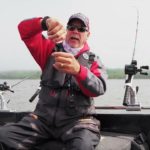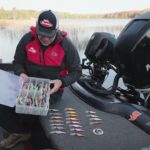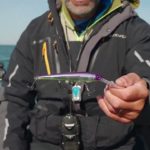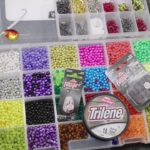Unconventional Tactics for Northern Ontario Spring Pike
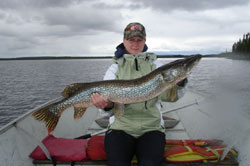 As the signs of winter start to disappear, anglers get antsy to hit the open water once again. The allure of catching trophy spring pike brings countless anglers to Northern Ontario each year and it is no wonder so many people choose this destination with its proven record of producing big fish, beautiful scenery and secluded Canadian wilderness.
As the signs of winter start to disappear, anglers get antsy to hit the open water once again. The allure of catching trophy spring pike brings countless anglers to Northern Ontario each year and it is no wonder so many people choose this destination with its proven record of producing big fish, beautiful scenery and secluded Canadian wilderness.
One popular northern escape for spring pike is none other than “The Trophy Northern Pike Capital of North America”; otherwise known as Little Vermillion Lake. One establishment that operates on the lake, Sportsman’s Lodge, adopted a "no kill trophy pike" policy in 1982 to ensure the fishery continues to produce big fish well into future generations. The dividends of this groundbreaking decision back in the 1980’s have been phenomenal. Year after year, anglers return to the lake to catch countless trophy pike and there definitely aren’t any signs of the fishery slowing down.
When planning spring trips it is very hard to anticipate weather conditions, even though they obviously play an extremely important role. Many areas across North America are starting to warm to summer-like temperatures in May, while springtime in Northern Ontario can be completely unpredictable. At the end of May in Northern Ontario, anglers should come to expect anything from warm, sunny conditions to sleet and snow. In one week at this time of year, one might be so lucky to experience all of these extremes. Remember to keep in mind that the ice is also just beginning to dissipate around the beginning of May, so depending on conditions for that year, floating ice on the water may also be something that anglers must contend with. Virtually nothing is impossible when considering the weather, so learning to fish unstable weather conditions can become your most valuable tool.
 When packing gear for a Northern Ontario getaway at this time of year, try to think outside of the box. Include your typical spring arsenal for getting those slow pike moving, things such as glide baits, small suspending jerk baits and even dead bait. Due to the unpredictable weather conditions, which can shut the fish down, be sure to include some extra tackle such as big plastics to move lazy, belly-to-bottom fish and large spoons for the unexpected feisty ones. These are sure bets to get the fish to bite when the weather is not reflecting ideal conditions. Don’t forget to bring trailers for your spoons either, a small grub on your hook can mean all the difference in the world. A portable fish finder will be one of the most valuable things you can pack. The quicker you can find the fish, the quicker they will end up on your line. Keep an open mind when packing your tackle box and throw in anything that you are not sure about, chances are that it might turn out to be beneficial.
When packing gear for a Northern Ontario getaway at this time of year, try to think outside of the box. Include your typical spring arsenal for getting those slow pike moving, things such as glide baits, small suspending jerk baits and even dead bait. Due to the unpredictable weather conditions, which can shut the fish down, be sure to include some extra tackle such as big plastics to move lazy, belly-to-bottom fish and large spoons for the unexpected feisty ones. These are sure bets to get the fish to bite when the weather is not reflecting ideal conditions. Don’t forget to bring trailers for your spoons either, a small grub on your hook can mean all the difference in the world. A portable fish finder will be one of the most valuable things you can pack. The quicker you can find the fish, the quicker they will end up on your line. Keep an open mind when packing your tackle box and throw in anything that you are not sure about, chances are that it might turn out to be beneficial.
Along with your tackle, outdoor gear is also something that should be considered when packing for a Northern Ontario spring trip. In warmer climates at this time of the year, a rain suit or a sweater may be all you need, but remember that you may experience some extreme and frigid spring weather. The last thing that you will want is to have to shorten your time on the water due to not being prepared. To make your days on the water comfortable bring along heavy jackets and pants, hats, gloves and boots. You know the old adage, better safe than sorry.
Little Vermillion Lake holds an excellent variety of structure. Rock walls, rocky shorelines, shallow bays, creeks and rivers with a variety of rock, sand and gravel bottoms provide excellent locations for fish to be found. The lake itself is not overly deep, but it does have some pockets containing deeper water as well as structural rocks lying just beneath the water’s surface. All of these ideal attributes make the lake a playground for trophy pike.
 Higher temperatures in May are slowly starting to warm the water, but a long, drawn out winter, or an early appearance of spring will have a great effect on where you can find fish. Textbook conditions for spring pike tell us that we can find pike holding in river mouths and shallow, weedy back bays after the spawn, but that is not always the case in the great white north. Sure, fish may be found in these areas, but putting aside this deep-rooted type of thinking can put you onto some bigger fish. Textbook spring pike patterns may or may not be useful at this time of year depending not only on the current weather conditions, but also on the conditions of the passing winter. An early spring may mean that post-spawn pike will be holding in typical areas, so work these areas well. If the results are not plentiful, unconventional tactics for cold weather fish will have to be used. The most difficult thing about this type of fishing is breaking away from that mindset of general spring techniques and attempting some different ones.
Higher temperatures in May are slowly starting to warm the water, but a long, drawn out winter, or an early appearance of spring will have a great effect on where you can find fish. Textbook conditions for spring pike tell us that we can find pike holding in river mouths and shallow, weedy back bays after the spawn, but that is not always the case in the great white north. Sure, fish may be found in these areas, but putting aside this deep-rooted type of thinking can put you onto some bigger fish. Textbook spring pike patterns may or may not be useful at this time of year depending not only on the current weather conditions, but also on the conditions of the passing winter. An early spring may mean that post-spawn pike will be holding in typical areas, so work these areas well. If the results are not plentiful, unconventional tactics for cold weather fish will have to be used. The most difficult thing about this type of fishing is breaking away from that mindset of general spring techniques and attempting some different ones.
Trolling is not generally associated with spring pike fishing, however it is what will get fish on your line when conventional techniques are not producing. Not only will you be able to cover a lot of water to find fish using this method, but you will also be able to trigger strikes from fish that are not interested in the casting patterns that are being thrown to them. Remember that although these fish are chasing trolled baits, they are still submersed in cold water. Slow trolling with long lines is what will win this battle. Keep your speeds slow enough to allow the lazy fish to follow and strike, but use enough speed to keep slow movements and wobbles in your baits. Try different trolling speeds and make minor adjustments until you find one that is effective. These speeds may need to be altered from day to day, but with only minor variances. Letting out long lines will help to keep lightweight baits deeper in the water. Again, try different lengths of line for each bait to figure out where the strike zone will be. Depending on the fish, this could be ticking bottom or riding just under the surface.
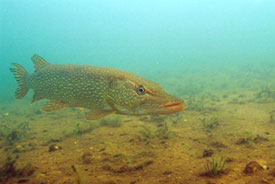 Rock walls and rocky shorelines can be the ticket for early spring pike fishing in Northern Ontario. When running alongside the different walls and shorelines you may see that fish are indeed holding there. Due to the relative shallow waters Little Vermillion Lake, the average depth in front of these productive spots will not be very deep. After trying different areas throughout the lake, you will be sure to find one that proves to be extremely productive, especially if you can find them near typical post-spawn holding areas. Look for areas with rock points that jut out from the walls or shorelines, and be sure to extend your casting or trolling run to include these areas. Those points can turn out to be your key to success.
Rock walls and rocky shorelines can be the ticket for early spring pike fishing in Northern Ontario. When running alongside the different walls and shorelines you may see that fish are indeed holding there. Due to the relative shallow waters Little Vermillion Lake, the average depth in front of these productive spots will not be very deep. After trying different areas throughout the lake, you will be sure to find one that proves to be extremely productive, especially if you can find them near typical post-spawn holding areas. Look for areas with rock points that jut out from the walls or shorelines, and be sure to extend your casting or trolling run to include these areas. Those points can turn out to be your key to success.
In using these techniques, we had a very successful Northern Ontario experience this past year. Within one week we saw sun, strong winds, heavy cloud cover, rain and even snow. With our portable fish finder, we were able to find a depth of between seven and ten feet in front of rocky shorelines and that was where our trolling passes were made. Pass after pass kept turning up bigger fish than the one before and we landed numerous fish over forty inches. We tried casting our productive spots, but that did not seem to be what the fish were after. Trolling was clearly the ticket. On Little Vermillion Lake, we found one particular sloping rock point that held large numbers of walleye, rightfully so, named Walleye Point. Despite the tough weather conditions, the pike were holding along this and similar points feeding on the walleye. They were actively chasing their prey, which was very surprising considering the cold weather conditions. Throwing all ingrained spring pike fishing knowledge aside is what made our week a success.
Although it can be very hard to put aside knowledge that we have practiced with great success for many years, it can sometimes be invaluable to do so. Unorthodox methods of fishing can seem hard to swallow but will pay off in the end. The biggest payoff however, will be to turn an otherwise slow fishing trip into the trip of a lifetime.
For world-class northern pike and walleye fishing, visit www.trophypikecanada.com for more information, call 1-800-465-1097, or email the Geary family at [email protected].


